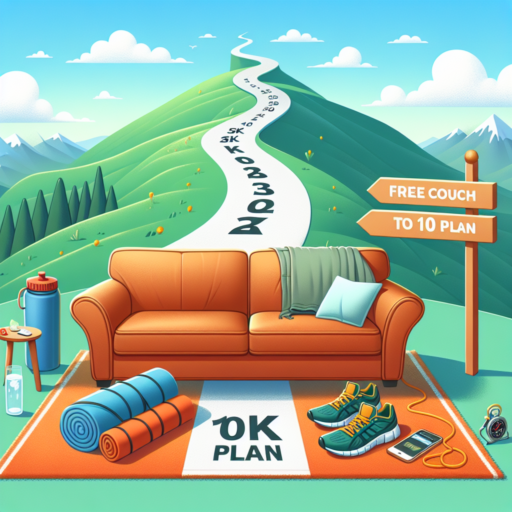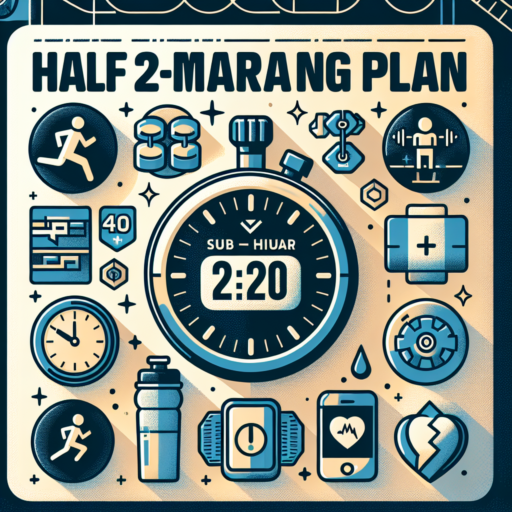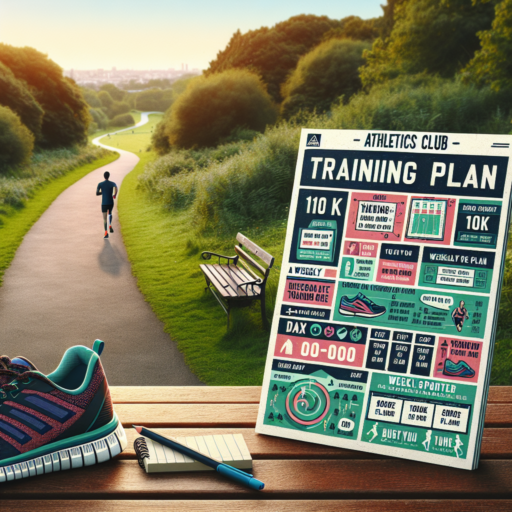Introduction to the Free Couch to 10K Plan
Welcome to the Free Couch to 10K Plan, the ultimate guide designed for beginners and intermediate runners aiming to achieve the significant milestone of running a 10-kilometer race. This plan is meticulously crafted to transition you from minimal physical activity to confidently completing a 10K distance, catering to those who are starting from the couch, hence the name. It’s perfect for individuals looking to improve their fitness, challenge themselves, and achieve personal goals in running.
Embarking on this journey will not only help you accomplish a considerable running distance but also significantly improve your overall health, stamina, and mental resilience. The Free Couch to 10K Plan is structured to gradually increase your running stamina, avoiding common injuries associated with sudden high-intensity workouts. It includes various workouts, rest days, and incremental challenges that ensure you are constantly progressing towards your goal without feeling overwhelmed.
The plan is divided into manageable weeks, each with its specific objectives and milestones, enabling runners to see their progress and stay motivated. From initial slow runs, rest days essential for recovery, to longer distances that test endurance, the plan promises a balanced approach to achieving your 10K run. Embrace the journey with enthusiasm as you step by step, shift from minimal activity to accomplishing a feat that seems daunting at first glance.
Getting Started: What You Need for Your Couch to 10K Journey
Embarking on a journey from couch to 10K is an admirable goal that speaks to both physical fitness and personal determination. However, knowing what you need before taking that first step is crucial for success. While motivation and perseverance are key ingredients, the right gear and preparation cannot be overlooked.
Essential Gear for Your 10K Training
First and foremost, investing in a good pair of running shoes is non-negotiable. Your shoes are the most critical piece of equipment you’ll need, as they will absorb the impact of the road and help prevent injuries. Additionally, consider acquiring comfortable, breathable running clothes to keep you cool and dry. High-quality socks designed for running can also make a significant difference, reducing the risk of blisters and discomfort.
Creating a Training Plan
Once you have your gear sorted, the next step is to develop a structured training plan. A well-crafted plan gradually increases in difficulty, preparing your body for the 10K distance without overdoing it. Including rest days in your schedule is essential for recovery and progress. Online resources, running apps, or even a personal coach can provide guidance and structure to your plan.
Nutrition and Hydration Strategies
Beyond the physical preparations, paying attention to your nutrition and hydration is pivotal. Fueling your body with the right nutrients ensures you have the energy for training sessions and recover properly afterward. Staying hydrated, especially on long runs, keeps your performance at its peak and prevents overheating.
Week-by-Week Breakdown: Your Free Couch to 10K Training Schedule
Embarking on a journey from the comfort of your couch to the exhilarating finish line of a 10K is an ambitious goal, but with the right guidance, it’s entirely achievable. This week-by-week breakdown is designed to transform beginner runners into 10K finishers, focusing on gradually increasing endurance, speed, and confidence. Let’s explore how you can leverage this free Couch to 10K training schedule to cross the finish line with your head held high.
Initial Weeks: Building a Solid Foundation
The first few weeks are crucial in laying the groundwork for your future success. You’ll start with short runs, interspersed with walking intervals, as you begin to build your stamina. These initial steps are designed to acclimate your body to regular running, making it crucial to stick to the schedule and resist the urge to skip ahead. Remember, patience and consistency are your best allies in these early stages.
Middle Weeks: Increasing Duration and Intensity
As you progress into the middle weeks of the training schedule, your runs will start to become longer and slightly more challenging. This is where you’ll begin to see significant improvements in your endurance. During this phase, your walking intervals will gradually decrease, and your continuous running time will increase. This transition is a pivotal moment in your training, as you shift from a beginner’s mindset to embracing the discipline of a dedicated runner.
Final Weeks: Sharpening Speed and Endurance
Approaching the culmination of your training, the focus shifts towards fine-tuning your speed and bolstering your endurance for the full 10K distance. It’s time to put your hard work to the test with longer uninterrupted runs, occasional speed work, and possibly even a practice race. These final weeks are designed to prepare you mentally and physically for race day, ensuring that you are ready to tackle the challenges of a 10K with confidence and enthusiasm.
Essential Tips to Enhance Your Couch to 10K Progress
Making the transition from couch to 10K is a challenging yet incredibly rewarding journey. It requires not just dedication and perseverance but also a strategic approach to training, recovery, and mental preparation. To help navigate through this transformative path, here are some indispensable tips that can significantly enhance your progress and ensure a smoother, more efficient progression towards your 10K goal.
Set Realistic and Incremental Goals
Embarking on your couch to 10K journey with a clear set of realistic, incremental goals is essential. Instead of focusing solely on the end goal of running 10 kilometers, break your training into smaller, manageable objectives. Celebrate each milestone, no matter how small, to keep motivation high and recognize your achievements. This approach not only makes the process less daunting but also allows for more consistent progress by reducing the risk of injury and burnout.
Focus on Cross-Training and Recovery
While running is at the core of your couch to 10K journey, incorporating cross-training activities such as cycling, swimming, or strength training can greatly enhance your aerobic capacity, strength, and running efficiency. Additionally, prioritizing recovery is crucial. Ensure you have adequate rest days, and consider integrating yoga or foam rolling into your routine to aid in muscle recovery and flexibility. These practices help prevent injuries and improve overall performance, making your training sessions more effective.
Embrace Nutritional Strategies
Proper nutrition plays a vital role in your couch to 10K progress. Fuelling your body with the right balance of carbohydrates, proteins, and healthy fats ensures you have the energy for your runs and the nutrients necessary for recovery and muscle repair. Hydration is equally important; make sure to drink plenty of water throughout the day, especially before and after your runs, to stay hydrated and maintain optimal performance levels.
Overcoming Common Challenges in the Couch to 10K Journey
Embarking on the Couch to 10K journey presents an inspiring challenge for many, yet it is accompanied by a set of common obstacles that can deter even the most motivated individuals. Understanding these hurdles and learning effective strategies to overcome them can transform this journey from a daunting task to an achievable goal.
Building Consistent Running Habits
One of the initial challenges faced in the Couch to 10K journey is developing and maintaining a consistent running schedule. Life’s unpredictable demands often interfere with our best-laid plans, leading to missed training sessions. Overcoming this requires a flexible yet committed mindset, prioritising running as an indispensable part of the day. Integrating short, manageable runs into your daily routine can gradually build endurance, making the process less overwhelming.
Dealing with Physical Strain
The physical demands of transitioning from minimal activity to running a 10K can lead to discouragement. Common physical challenges include muscle soreness, fatigue, and the risk of injury. To navigate these hurdles, it’s crucial to listen to your body and allow adequate time for recovery. Incorporating cross-training activities such as cycling or swimming can help build stamina while reducing the risk of overuse injuries. Additionally, ensuring proper nutrition and hydration supports muscle repair and overall performance.
Staying Motivated Throughout the Journey
Maintaining motivation over the weeks required to progress from couch to 10K is a challenge many face. Setting small, achievable goals and celebrating these milestones can provide a sense of accomplishment and keep the motivation high. Additionally, joining a running group or finding a running buddy can offer the social support and accountability needed to stay on track. Remember, the journey to 10K is as much about mental endurance as it is about physical stamina.
Nutrition and Hydration: The Fuel for Your 10K Success
Preparing for a 10K run encompasses more than just the physical training. An aspect equally crucial to your success is optimizing your nutrition and hydration. These elements are the very fuel that powers your body through the demanding training sessions leading up to the race and the event itself. By understanding the vital role they play, you can enhance your performance, recovery, and overall experience.
When it comes to nutrition, the focus should be on a balanced diet rich in carbohydrates, proteins, and healthy fats. Carbohydrates are your body’s primary energy source, essential for runners looking to maintain stamina across the kilometers. Incorporating a variety of whole grains, fruits, and vegetables ensures a steady supply of energy, while proteins aid in the repair and recovery of muscle tissues. Meanwhile, healthy fats provide long-term fuel, making them an important aspect of your dietary planning. Ensuring these nutritional elements are well-balanced can significantly impact your 10K training outcomes.
Hydration plays a pivotal role in your 10K success. Water regulates your body temperature, lubricates your joints, and aids in the transportation of energy-giving nutrients. Dehydration, even in its mild form, can impair your performance, making it crucial to stay well-hydrated before, during, and after your run. Understanding your body’s signals and learning how to hydrate effectively can be the difference between struggling and thriving on your 10K journey. Incorporating electrolyte-rich fluids can also help in maintaining the balance, especially during longer runs or in hot weather conditions.
Incorporating Cross-training and Rest Days into Your Plan
Understanding the importance of a well-rounded fitness routine is critical in achieving long-term athletic goals. Incorporating cross-training and rest days into your fitness regimen is not only beneficial for preventing injuries but also for enhancing overall performance. Cross-training allows you to engage different muscle groups, reducing the risk of overuse injuries, while rest days are essential for recovery and muscle repair.
Cross-training refers to incorporating various types of exercises aside from your main sport or activity. For example, if you’re a runner, cross-training might include cycling, swimming, or strength training. This variety helps maintain your fitness level while giving your primary muscles a break. It’s a strategic approach to fitness that can prevent boredom, boost motivation, and improve your skill set.
On the other hand, rest days are often overlooked in their significance. Adequate rest is crucial for physical and mental recovery. During rest days, your muscles repair and strengthen, and your body replenishes energy stores, preparing you for your next workout. Equally, rest days can include activities like yoga or light walking, which promote mobility and aid in the recovery process without overexerting the body.
Measuring Your Progress: Couch to 10K Tracking and Success Stories
Embarking on the journey from the couch to a full 10K can be both exhilarating and challenging. It’s a path that sees many ups and downs, both physically and emotionally. However, measuring your progress becomes a cornerstone aspect of ensuring you stay on track and motivated towards your goal. Let’s delve into how tracking your improvements is not just about numbers, but about personal achievements and setting new benchmarks.
The process of tracking your progress serves not only as a motivator but as a critical self-reflection tool. This can be done through various means such as running apps, wearable technology, or even a good old-fashioned journal. By keeping a detailed log of your runs, you’re able to see not just how far or fast you’ve run, but also how your endurance and health improve over time. This gradual improvement, documented in your tracking, becomes a roadmap of where you’ve been and an indicator of how close you’re getting to your 10K target.
Apart from personal milestones, the inspiration from success stories of those who’ve made it from the couch to 10K cannot be understated. These narratives often highlight the disciplined approach to tracking and self-improvement, offering a blueprint for others to follow. They showcase the importance of persistence, structured training, and the essential practice of monitoring progress. Success stories fuel the belief that anyone, with the right mindset and tools for tracking, can achieve their 10K dreams.
Adjusting the Couch to 10K Plan for Personalization and Injury Prevention
Embarking on a journey from the couch to completing a 10K run is an exhilarating challenge. However, the key to a successful transition lies in personalizing your running plan and taking proactive steps to avoid injuries. Initially, the idea of running long distances might seem daunting, but with the right adjustments, you can make the process not only achievable but enjoyable.
First and foremost, understanding your own body’s needs and limitations plays a crucial role in customizing your training plan. It’s essential to incorporate rest days, cross-training, and gradually increase your mileage to prevent overuse injuries. Additionally, listening to your body and adjusting your running schedule based on how you feel can significantly reduce the risk of injuries. For instance, incorporating flexibility and strength exercises can enhance your muscles’ ability to handle the stress of running, contributing to a safer training experience.
Utilizing technological tools and resources can also play a pivotal role in personalizing your Couch to 10K journey. Apps and wearable technology offer valuable insights into your performance, pacing, and can even suggest recovery times based on your physical activity. By paying close attention to this data, you can tailor your training regimen to better suit your individual pace and progression, ensuring a smoother transition from novice to 10K runner. Remember, the goal is to gradually build your endurance and strength while fostering a love for running, which means making adjustments based on personal progress and fitness levels.
Crossing the Finish Line: What to Do After Completing Your Couch to 10K
After dedicating weeks or even months of effort in transitioning from the couch to finishing a 10K, you’ve finally crossed that coveted finish line. However, the end of the race doesn’t mean your fitness journey is over. It’s crucial to understand the next steps in order to maintain the gains you’ve achieved and set new goals for your ongoing fitness journey.
Maintaining Momentum is key after such a significant achievement. It’s easy to fall into a lull after reaching your goal, but keeping the inertia of your training can lead to even greater accomplishments. Consider setting new targets, whether it’s improving your 10K time, participating in a half marathon, or perhaps exploring different forms of exercise that complement the endurance and strength you’ve built.
Rest and Recovery
Allowing your body to rest post-race is as essential as the training leading up to it. Getting ample sleep, staying hydrated, and perhaps indulging in a massage or gentle yoga session can significantly aid in your recovery. This period of rest isn’t about halting your progress but rather ensuring your body is adequately recuperated to tackle the next challenge.
Reflect and Revise
Reflection on your Couch to 10K journey can offer invaluable insights for future endeavors. Assess what worked well in your training and what you’d like to improve. Revision of your training regime, nutrition, and even recovery practices can make a big difference in your next race or fitness goal. Setting a new benchmark for yourself doesn’t just push your limits; it reshapes them.










